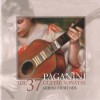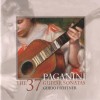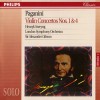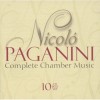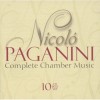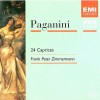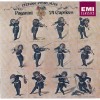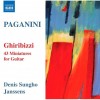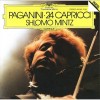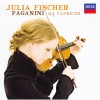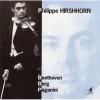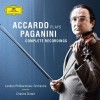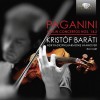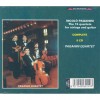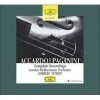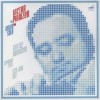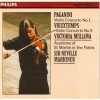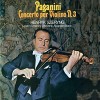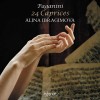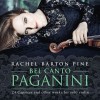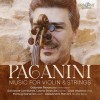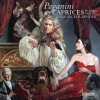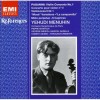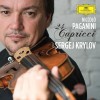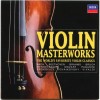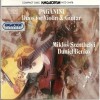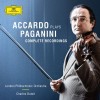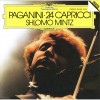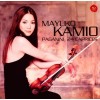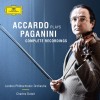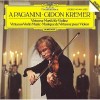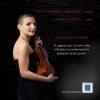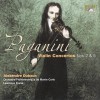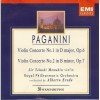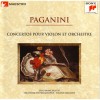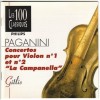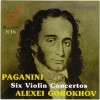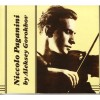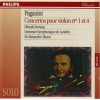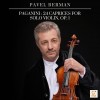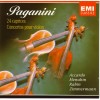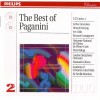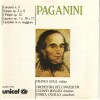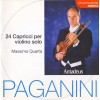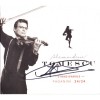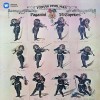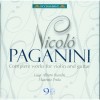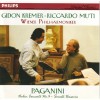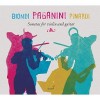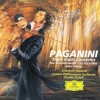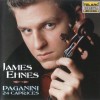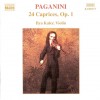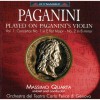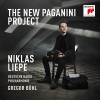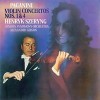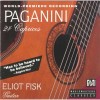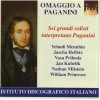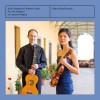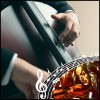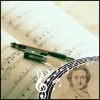Biography
Childhood and early career
Niccolò Paganini was born in Genoa, Italy, the third of the six children of Antonio and Teresa (née Bocciardo) Paganini. Paganini's father was an unsuccessful trader, but he managed to supplement his income through playing music on the mandolin. At the age of five, Paganini started learning the mandolin from his father, and moved to the violin by the age of seven. His musical talents were quickly recognized, earning him numerous scholarships for violin lessons.
The young Paganini studied under various local violinists, including Giovanni Servetto and Giacomo Costa, but his progress quickly outpaced their abilities. Paganini and his father then traveled to Parma to seek further guidance from Alessandro Rolla. But upon listening to Paganini's playing, Rolla immediately referred him to his own teacher, Ferdinando Paër and, later, Paër's own teacher, Gasparo Ghiretti. Though Paganini did not stay long with Paër or Ghiretti, the two had considerable influence on his composition style.
The French invaded northern Italy in March 1796, and Genoa was not spared. The Paganinis sought refuge in their country property in Ramairone. And by 1800, Paganini and his father traveled to Livorno, where Paganini played in concerts and his father resumed his maritime work. In 1801, Paganini, aged 18 at the time, was appointed first violin of the Republic of Lucca, but a substantial portion of his income came from freelancing. His fame as a violinist was matched only by his reputation as a gambler and womanizer.
In 1805, Lucca was annexed by Napoleonic France, and the region was ceded to Napoleon's sister, Elisa Baciocchi. Paganini became a violinist for the Baciocchi court, while giving private lessons for her husband, Félix. In 1807, Baciocchi became the Grand Duchess of Tuscany and her court was transferred to Florence. Paganini was part of the entourage, but, towards the end of 1809, he left Baciocchi to resume his freelance career.
Travelling virtuoso
For the next few years, Paganini returned to touring in the areas surrounding Parma and Genoa. Though he was very popular with the local audience, he was still not very well known in Europe. His first break came from an 1813 concert which took place at La Scala in Milan. The concert was a great success, and as a result Paganini began to attract the attention of other prominent, albeit more conservative, musicians across Europe. His early encounters with Charles Philippe Lafont and Ludwig Spohr created intense rivalry. His concert activities, however, were still limited to Italy for the next few years.
His fame spread across Europe with a concert tour that started in Vienna in August, 1828, stopping in every major European city in Germany, Poland, and Bohemia until February, 1831 in Strasburg. This was followed by tours in Paris and the British Isles. His technical ability and his willingness to display it received much critical acclaim. In addition to his own compositions, theme and variations being the most popular, Paganini also performed modified versions of works (primarily concertos) written by his early contemporaries, such as Rodolphe Kreutzer and Giovanni Battista Viotti.
Late career and health decline
Throughout his life, Paganini was no stranger to chronic illnesses. His frequent concert schedule, as well as his extravagant lifestyle, eventually took their toll on his health. He was diagnosed with syphilis as early as 1822, and his remedy, which included mercury and opium, resulted in serious health and psychological problems. In 1834, while still in Paris, he was treated for pulmonary tuberculosis. Though his recovery was reasonably quick, his future career was marred with frequent cancellations due to various health concerns, from common cold to depression, which lasted from days to months.
In September 1834, Paganini put an end to his concert career and returned to Genoa. Contrary to popular beliefs (involving him wishing to keep his music and techniques secret), Paganini devoted his time to the publication of his compositions and violin methods. He also accepted students, from which two enjoyed moderate success: violinist Camillo Sivori, and cellist Gaetano Ciandelli. Neither of them considered Paganini helpful or inspirational, however. In 1835, Paganini returned to Parma, this time under the employ of Archduchess Marie Louise of Austria, Napoleon's second wife. He was in charge of reorganizing her court orchestra. Unfortunately, he eventually became at odds with the players and Court, that his visions never saw the light of day.
Final years, death and burial
In 1836, Paganini returned to Paris to set up a casino. Its immediate failure left him in financial ruins, and he auctioned off his personal effects, including his musical instruments, to recuperate his losses. On Christmas of 1838, he left Paris for Marseilles and, after a brief stay, left for Nice. Paganini, wrongfully assuming it a premature gesture, refused the Last Rites to be performed on him from the local parish. However, on May 27, 1840, Paganini died from internal hemorrhaging, before a priest could be summoned.
It was on these grounds, and his publicized association with the Devil, that his body was denied a Catholic burial in Genoa. It took four years, and an appeal to the Pope, before the body was allowed to be transported to Genoa, but not buried. His remains were finally put to rest in 1876, in a cemetery in Parma. In 1893, the Czech violinist, Franz Ondricek, persuaded Paganini's grandson, Attila, to allow a viewing of the violinist's body. After the bizarre episode, Paganini's body was exhumed once again, to a new cemetery in Parma, in 1896.
Personal and professional relationships
Though having no shortage of romantic conquests, Paganini was once seriously involved with a singer named Antonia Bianchi from Como, who he met in Milan in 1813. They both concertized together throughout Italy. They had a son, Achilles Cyrus Alexander, born on July 23, 1825 in Palermo. Though their union was never legalized, it ended around April 1828 in Vienna. Paganini brought up Achilles on his European tour, raising him while pursuing his concerts. Achilles would later accompany his father until the latter's death, and was instrumental in dealing with his father's burial, years after his death.
Throughout his career, Paganini also became close friends with composers Gioachino Rossini and Hector Berlioz. Rossini and Paganini met in Bologna in the summer of 1818. In January 1821, on his return from Naples, Paganini met Rossini again in Rome, just in time to become the composer's substitute conductor for his opera Mathilde de Sharbran, upon the sudden death of the original conductor. The violinist's efforts earned a lasting gratitude from the composer.
Meanwhile, Paganini was introduced to Berlioz in Paris in 1833. Though Paganini also commissioned from him Harold in Italy for viola and orchestra, the violinist never performed it, and instead it was premiered a year later by violist Christian Urhan. Despite his alleged disinterest in Harold, Paganini often referred to Berlioz as the resurrection of Beethoven and, towards the end of his life, he gave large sums of his fortune to the composer.
Paganini's instruments
Paganini was in possession a number of fine string instruments. More legendary was some of the circumstances under which Paganini obtained (and lost) them. While still a teenager in Livorno, a wealthy businessman named Livron lent him a Guarneri for a concert. Livron was so impressed with Paganini's playing that he refused to take it back. This particular violin would come to be known as Il Cannone[1].
In a later occasion, in Parma, he won another valuable violin (also by Guarneri) after a difficult sight-reading challenge brought on by a man with the name of Pasini.
Compositions
Paganini composed his own works to play exclusively in his concerts, all of which had profound influences on the evolution of violin techniques. His 24 Caprices were probably composed in the period between 1805 to 1809, while he was in the service of the Baciocchi court. Also during this period, he composed the majority of the sonatas and quartets for the guitar. Many of his variations (and he has become the de facto master of this musical genre), including Le Streghe, The Carnival of Venice, and Nel cor più non mi sento, were composed, or at least first performed, before his European concert tour.
Generally speaking, Paganini's compositions were technically imaginative, and the timbre of the instrument was greatly expanded resulting from these works. Sounds of different musical instruments and animals were often intimated. One such composition was titled Il Fandango Spanolo (The Spanish Dance), which featured a series of humorous imitation of farm animals. Even more outrageous was a solo piece Duetto Amoroso, in which the sighs and groans of lovers were intimately depicted on the violin. Unfortunately, there were no surviving manuscripts of both pieces; their existence were only known through concert posters.
However, his works were criticized for lacking characteristics of true polyphonism, as pointed out by Eugène Ysaÿe. Yehudi Menuhin, on the other hand, identified that this might have been the result of his reliance on the guitar (in lieu of the piano) as an aid in composition. His orchestral parts (for his concertos) were often polite, unadventurous, and clearly supportive.
Paganini was also the inspiration of many prominent composers. Both "La Campanella" and the A minor caprice (Nr. 24) have been an object of interest for a number of composers. Franz Liszt, Johannes Brahms, Sergei Rachmaninoff, Boris Blacher, Andrew Lloyd Webber, George Rochberg and Witold Lutosławski, among others, wrote well-known variations on these themes.
Legacy
Evolution of violin technique
The Israeli violinist Ivry Gitlis once referred to Paganini as a phenomenon rather than a development. Though some of the violinistic techniques frequently employed by Paganini were already present, most accomplished violinists of the time focused on intonation and bowing techniques, the so-called right-hand techniques for string players. Arcangelo Corelli (1653-1713) was considered a pioneer in transforming the violin from an ensemble instrument to a solo instrument. In the mean time, the polyphonic capability of the violin was firmly established through the Sonatas and Partitas BWV 1001-1006 of Johann Sebastian Bach (1685-1750). Other notable violinists included Antonio Vivaldi (1678-1741) and Giuseppe Tartini (1692-1770), who, in their compositions, reflected the increasing technical and musical demands on the violinist. Although the role of the violin in music had been drastically changed through this period, progress on violin technique was steady but slow up to this point. Any study of techniques requiring agility of the fingers and the bow was still considered unorthodox and discouraged by the established community of violinists.
Much of Paganini's playing (and his violin compositions) were influenced by two violinists, Pietro Locatelli (1693-1746) and Auguste Frederick Durand (1770-????). During Paganini's study in Parma, he came across the 24 Caprices of Locatelli (entitled L'arte di nuova modulazione - Capricci enigmatici or The art of the new style - the enigmatic caprices). Published in the 1730s, they were shunned by the musical authorities for its technical innovations, and were forgotten by the musical community at-large. Around the same time, Durand, a former student of Giovanni Battista Viotti (1755-1824), became a celebrated violinist. He was renowned for his use of harmonics and left hand pizzicato in his performance. Paganini was impressed by Durand innovation and showmanship, which later also became the hallmarks of the young violin virtuoso. Paganini was instrumental in the revival and popularization of these violinistic techniques, which are now incorporated into regular compositions.
Another aspect of Paganini's violin techniques concerned his flexibility. He had exceptionally long fingers and was capable of playing three octaves across four strings in a hand span, a feat that is still considered impossible by today's standards. His seemingly unnatural ability might have been a result of Marfan syndrome or Ehlers-Danlos syndrome.





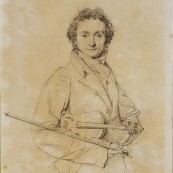

![Russian legends - Viktor Tretiakov [6 CD]](http://static.classicalm.com/repository/collection-cover/small/271-img1318800770253179.jpg)
![Russian legends - Gidon Kremer [10 CD]](http://static.classicalm.com/repository/collection-cover/small/273-img1318873589669975.jpg)
![Russian legends - Leonid Kogan [10 CD]](http://static.classicalm.com/repository/collection-cover/small/269-img1318707830156876.jpg)
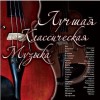
![Deutsche Grammophon Classic Gold [CD 1 of 3]](http://static.classicalm.com/repository/collection-cover/small/1314-img1361380277394437.jpg)
![Top 100 der Klassik [CD 3 of 5]](http://static.classicalm.com/repository/collection-cover/small/1366-img1372593555699508.jpg)


![In the South [Brodsky Quartet]](http://static.classicalm.com/repository/disk-cover/small/4085-img1409754445889055.jpg)
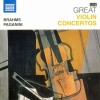
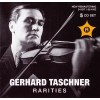
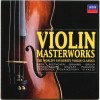
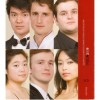
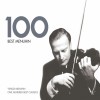
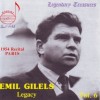
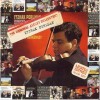
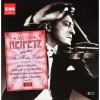
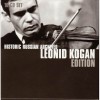
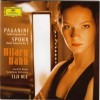

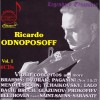
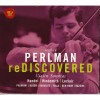
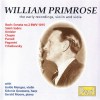
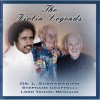
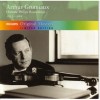
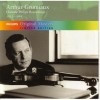
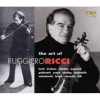
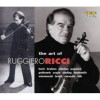
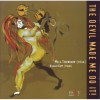
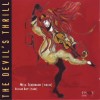
![Oskar Sala - Der Trautonium - Spieler Oskar Sala [CD1of2]](http://static.classicalm.com/repository/disk-cover/small/3696-img1406987084879276.jpg)
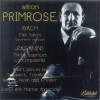
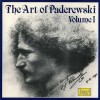
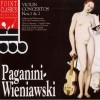
![Andres Segovia. A Centenary Celebration. [CD 1 of 3]](http://static.classicalm.com/repository/disk-cover/small/2962-img1365010036358113.jpg)
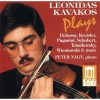
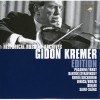
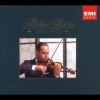
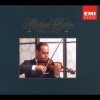
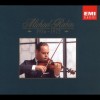
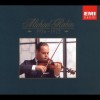
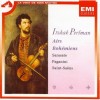
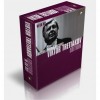
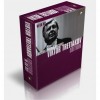
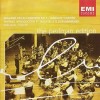
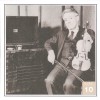
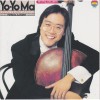
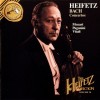
![The Heifetz Collection, Volume 1 [3 CD ]](http://static.classicalm.com/repository/disk-cover/small/715-img1315088819334029.jpg)
![The Heifetz Collection, Volume 2 [3 CD]](http://static.classicalm.com/repository/disk-cover/small/717-img1315129517717299.jpg)
![The Heifetz Collection, Volume 3 [2 CD]](http://static.classicalm.com/repository/disk-cover/small/719-img1315174118757085.jpg)
